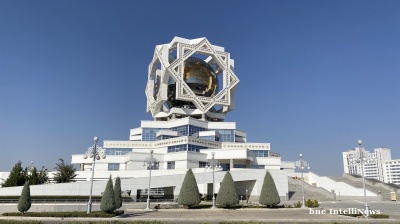“There’s no there there,” Gertrude Stein said famously about her native Oakland. She meant to convey nostalgia for her bygone childhood home and desperate longing for a place which had lost every human significance, becoming what modernist anthropologists call a non-place like hotel rooms, border posts and airports.
I arrive in Narva at about 1pm on a May afternoon. It’s snowing, the “colour” palette exhibits all the shades of a monochrome TV set, my phone just welcomed me to Russia, and I see only a handful of old people around the train station, situated by the river. A small railway bridge stands next, covered in haze, giving few clues as to what is on “the other side”.
I travelled to Narva with no prejudice, but what greeted me was so steeped in the stereotype of non-place that Stein’s words came into my head. However, despite the eerie first appearance and a palpably tense atmosphere, there is a reason for Narva to be “there”, on the edge of Europe.
The city has been at the centre of important trade routes between Northern and Eastern European empires since time immemorial. Its border crossing is still one of the busiest between the EU and Russia, both for goods and people.
According to data provided by the city administration, Russia’s war on Ukraine – and the ensuing EU sanctions on trade and block on Schengen visas – had indeed slowed down transits, but not nearly as much as the COVID-19 pandemic and related restrictions on both sides, which dealt a real blow to the city’s economy.
The town’s liminal nature earned it international fame and even a mention in Netflix’s series Homeland, along with hordes of tourists coming to see the city’s main attraction: its cumbersome neighbour Russia, as Mayor Katri Raik bluntly conceded in a BBC podcast.
Narva, the largest easternmost city in the European Union (and Nato), is separated from the Russian Federation by a stretch of 70 metres of placid waters. Fishermen launch their lines undisturbed from the promenade, seemingly in defiance of the border, which runs in the middle of the river. On the other side, you can barely see anyone: just some guards in green uniforms and a few people crossing the bridge on foot. Russia designated Ivangorod – the town which lies across the river – as a restricted zone, freely accessible only by residents, tourists with a special permit or people crossing the border.
Narva is Estonia’s third largest city and sits on the western banks of the eponymous river near its mouth on the Baltic Sea, a three-hour train ride from the hip capital Tallinn; Saint Petersburg is much closer, only 150 kilometres to the east.
The town is home to 54,000 people – 84% of which are Russian speaking and 35% holding a Russian passport – and a beautiful medieval castle built by the Danes in the 13th century. Its stunning 51-metre tower stands overlooking the river, bearing the scars of invasions by the Germans, Swedes and Russians and, eventually, a Soviet bombing raid in 1944 that severely damaged it.
The Soviets, after razing Narva to the ground, gifted it with an infinite array of prefabricated grey building blocks of dubious quality. Time was not kind to them, so today they make East German plattenbaus look like refined pieces of architecture by comparison.
On the castle’s recently restored tower proudly flies the Estonian flag. On the other side of the river, menacingly close, the Russian one hangs from a massive building: the Ivangorod Fortress, built by Ivan III “The Great” in 1492.
Until 1991, Ivangorod was a detached outpost of Narva, separated from the main town by what is still called the “Friendship Bridge”. Then the Soviet Union collapsed, and the bridge morphed into a border. This split families and relationships, marking a frontier which further hardened when Estonia joined the European Union and Nato in 2004.
In February 2022, after Russia launched its full-scale invasion of Ukraine, it became a symbol of the new “iron curtain” that descended upon Europe.
The other side
Across the castle – and next to the Estonian border post which leads to the bridge – is Narva’s town hall. There I’m greeted by Aleksandra Grünvald, the city’s press attaché, who kindly offers me tea or coffee while I wait to meet the vice mayor. I joke: “I’ll take tea. We’re still on the safe side, aren’t we?”. She answers, with a grin: “Is it so bad the fear of ‘the other side?’”.
Her words make clear a cultural divide: my “fear” and suspicion towards Russia, shaped during my upbringing in Western Europe and worsened after last year’s events, is not commonly shared in Narva.
Understandably. The “other side” was also Narva, until just 31 years ago. Russian is still the language of choice here, despite the government’s botched attempts to integrate the population by replacing all street signs in Estonian. The majority of Narva’s residents, regardless of their passports, identify as ethnic Russians.
Irina Smirnova is Narva’s vice-mayor: a young woman, full of energy and fluent in English, who lived in Australia and Cyprus but eventually returned to her native land to serve her community.
“We are just normal people, who live a normal life and want our children to grow up here in peace. We don’t see signs on people’s foreheads telling us that they’re Russian or Estonian, we all get along,” she says, betraying some irritation at what she calls a “media obsession” with Narva, too often morbidly depicted as a tense and divided non-place.
Yet tensions do exist here, where an ageing population used to regularly watch Russian TV channels. “That happened with my mom. She staunchly believed all the lies spread by the Kremlin through their TV channels. Culturally that [invasion] was too much of a shock for her: she couldn’t see Russia as an aggressor. She didn’t speak to me for months, our opinions were too divergent and that was painful,” Grünvald says.
“But eventually, she came along. After emotions subsided, she realised that the war was real, that people were dying in Ukraine and started to see things more rationally,” she adds.
Grünvald’s mom embodies the agonising conundrum that faced a large part of Narva’s elderly population, torn between conflicting information about the war. But the way the city responded also created a glimmer of hope. The city started to publish a weekly newspaper in Russian, freely delivered door-to-door, to provide everyone with reliable information in a familiar language.
Some, though, are still struggling to come to terms with reality: Last August, the Estonian government mandated the removal of a Soviet tank on the outskirts of Narva. The move stirred up tensions in town, and today “nostalgic people still go there to lay flowers on the empty pedestal”, Grünvald says.
Shrinking population
The city has evidently benefited from consistent EU funding in recent years. Streets and sidewalks are currently undergoing extensive renovation.
The waterfront promenade was revamped thanks to a €4mn EU funding programme – which partly also went to Ivangorod in 2019. Narva’s long riverside is pleasant and showcases panoramic spots, children’s playgrounds and a glitzy gym with a view over the fortress.
On the Ivangorod side, barely any modern infrastructure is visible; this has led to speculation about possible embezzlement of EU funds by the Russian authorities.
“There was never a great deal of cooperation with Ivangorod, but naturally after the invasion we halted all joint projects,” Smirnova points out.
A shiny, new campus of Tartu University opened in 2012 on Narva’s main square, right next to the recently restored old town hall – the only Baroque building that survived the Soviet WWII bombardments. “That really helped draw young people from other parts of Estonia, Russia and even Europe to Narva,” Irina says, noting how the city’s biggest challenge today is its shrinking population.
“Narva was planned for 80,000 inhabitants in Soviet times, now we have got 54,000 residents but that number is dwindling," Smirnova says. "Young people tend to emigrate to Tallinn or abroad due to poor job perspectives, we need to find new ways to entice them here.”
Almost 30,000 Ukrainian refugees, evacuated through Russia, have transited through Narva since last February. Most continued onwards towards other European destinations, but 861 of them decided to make Narva their home, contributing to improving the city’s troubled demographics.
The issues faced by Smirnova are not that different from her colleagues in small rural towns in France or Italy: high unemployment and youth emigrating en masse. Narva’s troubled location, “where Europe ends and the ‘evil’ begins”, does not deprive it of the common problems shared by other disadvantaged European towns.
“Yes, this is where Europe starts. We feel European. I really wish more people would visit Narva to enjoy its culture and peaceful environment,” Smirnova says.
After all, “there” is something. It’s a welcoming city, still reckoning with a painful history, but tirelessly working to improve things. Hopeful for a brighter future.
“We just want peace, like everybody else. We’re trying to be positive and get on with our life. What else should we do?”
When I leave Narva in the evening, the sun is shining. The two majestic fortresses are still there, facing each other with their weight of history, but their sight by the river is now blissfully enchanting. Peaceful, I could almost say.
Features

COMMENT: For Asia, dealing with Europe isn’t about achieving success; it’s about concealing failure
To be taken seriously in Asia, Europe must rediscover the courage to deliver, not merely declare. Asia has moved on to execution. Europe is still editing its initial policy draft.

Washington has a new focus on a Caspian energy play
For most of the last three decades since winning independence, Central Asia has been a bit of a backwater. Not any more. The Trump administration is becoming more focused on Turkmenistan's vast gas reserves and can smell money and power there.

BOTAŞ and Turkey’s hub ambition: from “30-year dream” to cross-border reality
For Ankara, the symbolism is as important as the molecules: Turkey’s energy map is shifting from end-market to hub.





